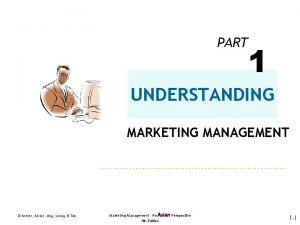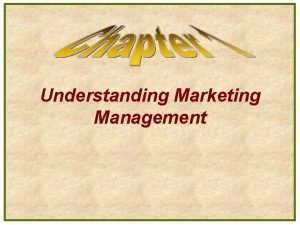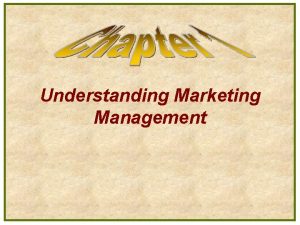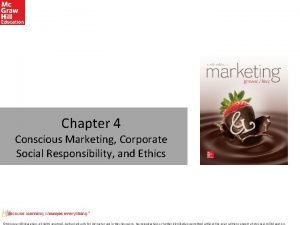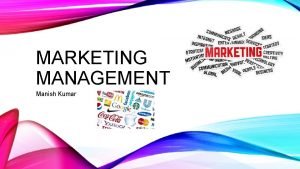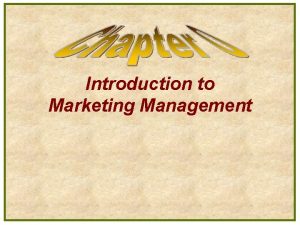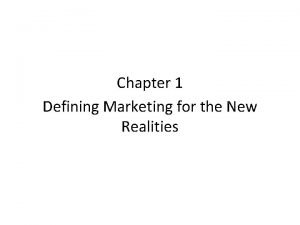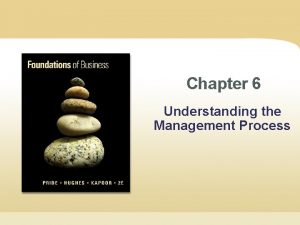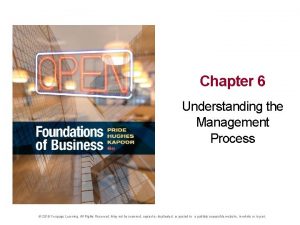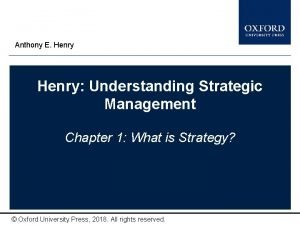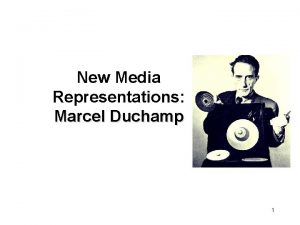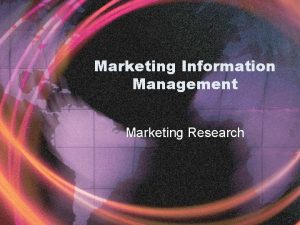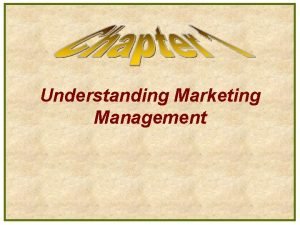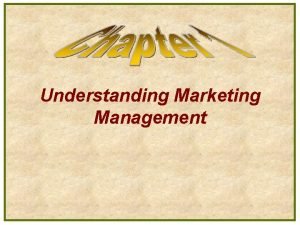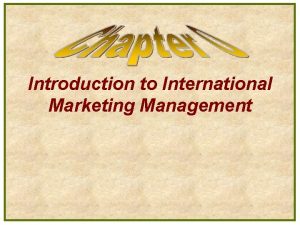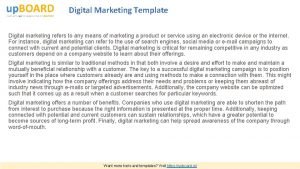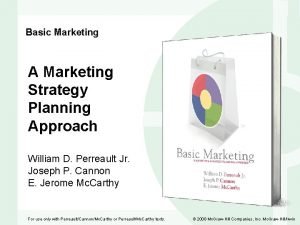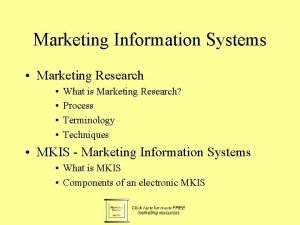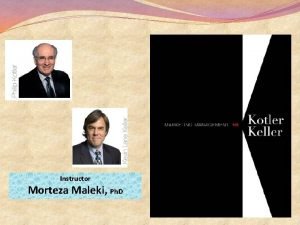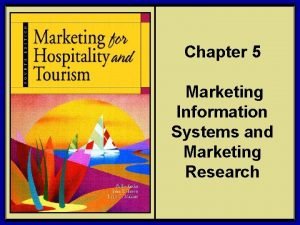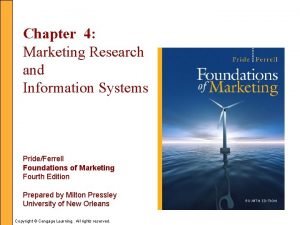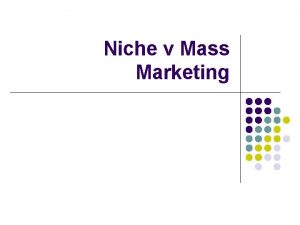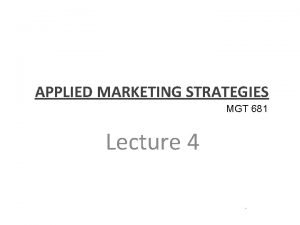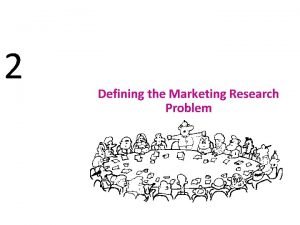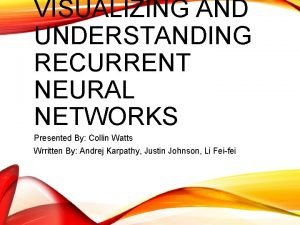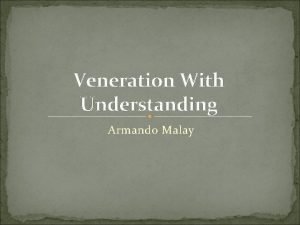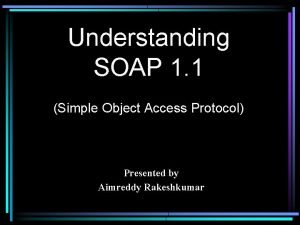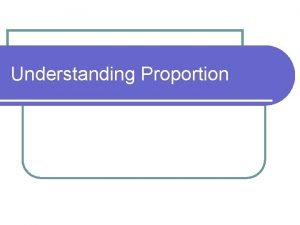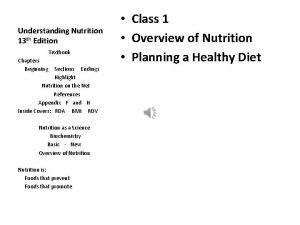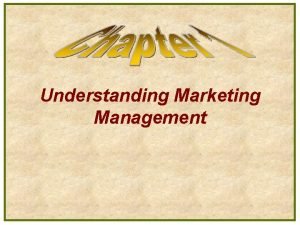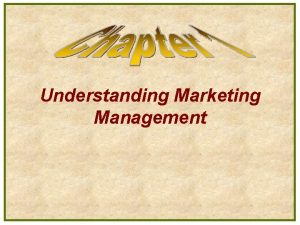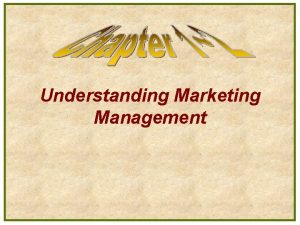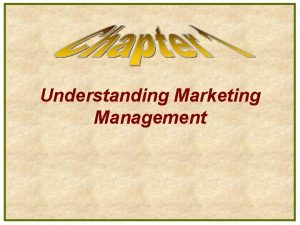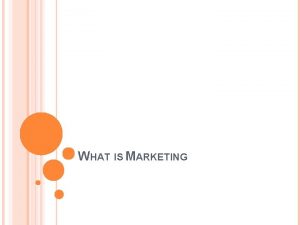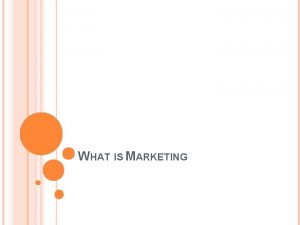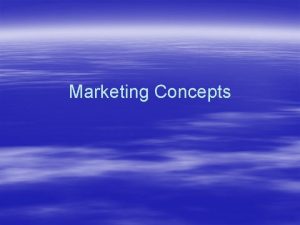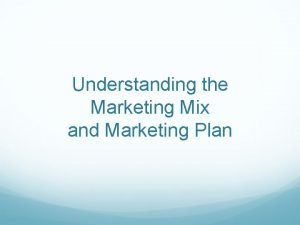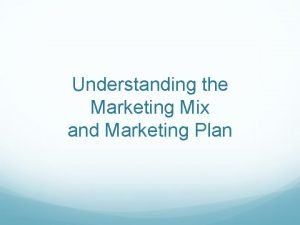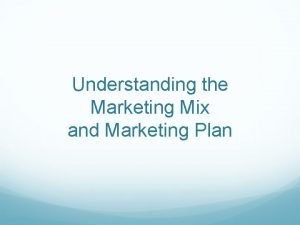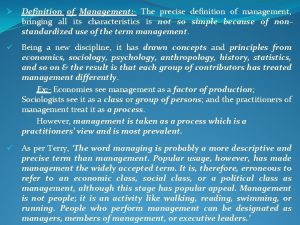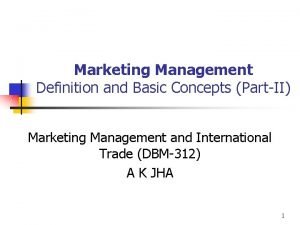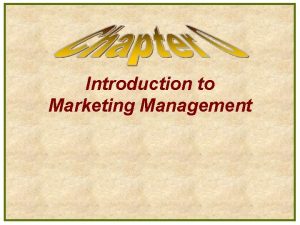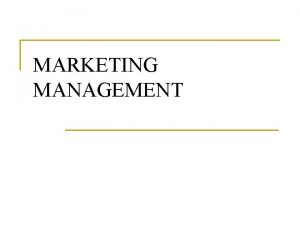Understanding Marketing Management Definition of Marketing l l


































































- Slides: 66

Understanding Marketing Management

Definition of Marketing l l The American Marketing Association (Approved October 2007): Marketing is the activity, set of institutions, and processes for creating, communicating, delivering, and exchanging offerings that have value for customers, clients, partners, and society at large. The shortest definition: Marketing is meeting needs profitably.

Peter Drucker’s Perspective on Marketing l There will always, one can assume, be need for some selling. But the aim of marketing is to make selling superfluous. The aim of marketing is to know and understand the customer so well that the product or services fits him and sells itself. Ideally, marketing should result in a customer who is ready to buy. All that should be needed then is to make the product or service available.

Definition of Marketing Management l Marketing management is the art and science of choosing target markets and getting, keeping, and growing customers through creating, delivering, and communicating superior customer value.

What is Marketed? Goods Services Events & Experiences Persons Places & Properties Organizations Information Ideas


National Milk Processors Education Program

Core Marketing Concepts l l l Needs, wants and demands Target markets, positioning, and segmentation Offerings and brands Value and satisfaction Marketing channels: consist of communication channels, distribution channels, and service channels.

Core Marketing Concepts l l l Supply chain: a longer channel stretching from raw materials to components to final products that are carried to final buyers. Competition Marketing environment: consist of the task environment and the broad environment

Needs, Wants and Demands l Needs (需要): the basic human requirements. l l l Physical: food, clothing, shelter, safety Social: belonging, affection Individual: learning, knowledge, self-expression Wants (慾望): when needs are directed to specific objects that might satisfy the need. Demands (需求): wants for specific products backed by an ability to pay.

Does Marketing Create or Satisfy Needs? Take a position: Marketing shapes consumer needs and wants versus Marketing merely reflects the needs and wants of consumers.

Responsive, Anticipative, and Creative Marketing l l l A responsive marketer finds a stated need and fills it. An anticipative marketer looks ahead into what needs customers may have in the near future. A creative marketer discovers and produces solutions customers did not ask for but to which they enthusiastically respond. l l Akio Morita (盛田昭夫) once proclaimed that Sony doesn’t serve markets; Sony creates markets. The Walkman is a classic example. 3 M: “Our goal is to lead customers where they want to go before they know where want to go. ”

Demand States and Marketing Tasks l Marketing managers are responsible for demand management. l l Negative demand → counter marketing, e. g. insurance. Non-existent demand → stimulus, e. g. encyclopedias. Latent demand → developing, e. g. solar energy, Kindle. Declining demand → remarketing, e. g. Arm & Hammer, Listerine, and 嬌生嬰兒洗髮精.

Demand States and Marketing Tasks l Marketing managers are responsible for demand management. l l Irregular demand → synchromarketing (同步行銷), e. g. 黑松沙士, happy hour. Full demand → maintain marketing Overfull demand → demarketing (低行銷), e. g. Mister Donut, 王師父金月娘. Unwholesome demand → social marketing, e. g. cigarettes, drunk-driving, anorexia, and 讓座.

Can you name a category of products for which your negative feelings have softened? What precipitated this change?

Company Orientations Toward the Marketplace l l l The production concept The product concept The selling concept The marketing concept The holistic marketing concept

The Production Concept l l The idea that consumers will prefer products that are widely available and inexpensive. Focus: high production efficiency, low costs, and mass distribution. It is useful when (1) the demand for a product exceeds the supply (e. g. , developing countries such as China); (2) the product’s cost is too high. Examples: Ford’s Model-T, standard raw materials and components, CD, LCD.

The Product Concept l l l The idea that consumers will prefer products that offer the most quality, performance, or innovative features. Focus: making superior products and improving them over time. Examples: digital camera, CPU. Better mousetrap fallacy Marketing myopia (Theodoes Levitt, 1960)

Product-Oriented vs. Market. Oriented Definitions of a Business

The Selling Concept l l The idea that consumers will not buy enough of the firm’s products unless it undertakes a large-scale selling and promotion effort. The selling concept assumes that customers who are coaxed into buying the product will like it. Or, if they don’t like it, they will possibly forget their disappointment and buy it again later.

The Selling Concept l l l Sergio Zyman (Coca-Cola’s former vice president of marketing): the purpose of marketing is to sell more stuff to more people more often for more money to make more profit. Focus: undertake an aggressive selling and promotion effort. Practiced most aggressively with unsought goods (e. g. , insurance, encyclopedias, and funeral plots).

The Marketing Concept l l The idea that the key to achieving organizational goals consists of the company being more effective than competitors in creating, delivering, and communicating superior customer value to its chosen target markets. The marketing concept emerged in the mid-1950 s. Slogans: “Find wants and fill them”, “Love the customer, not the product”, and “We do it all for you” (Toyota). Three hurdles: organized resistance, slow learning, and fast forgetting.

Marketing Concept vs. Selling Concept Selling concept Marketing concept Focus on the needs of the seller (Theodore Levitt, buyer (Theodore Levitt, 1960) The manufacturer: “This is The consumer: “This is what I make, won’t you what I want, won’t you please buy it” please make it” Inside-out perspective Outside-in perspective

Contrast between the Selling Concept and the Marketing Concept

The Extreme of the Marketing Concept – The Customer Concept

The Holistic Marketing Concept l l Based on the development, design, and implementation of marketing programs, processes, and activities that recognize their breadth and interdependencies. An approach to marketing that attempts to recognize and reconcile the scope and complexities of marketing activities.

Holistic Marketing Dimensions

Integrated Marketing l l The marketer’s task is to devise marketing activities and assemble fully integrated marketing programs to create, communicate, and deliver value for consumers. Mc. Carthy’s four P’s (the seller’s point of view) l l Product Price Place Promotion

Integrated Marketing l From a buyer’s point of view, each marketing tool is designed to deliver a customer benefit. l l Solution: How can I solve my problem? Information: Where can I learn more about it? Value: What is my total sacrifice to get this solution? Access: Where can I find it?

The Four P Components of the Marketing Mix

Marketing-Mix Strategy

Internal Marketing l l The task of hiring, training, and motivating able employees who want to serve customers well. Marketing must be embraced by the other departments (e. g. production, finance, and human resource); they must also “think customer. ”

An Example of a Coordination Problem that Requires Effective Internal Marketing Question: What would you do if you were the VP of marketing in this airline? How would internal marketing be of help? Show specific examples 33


Socially Responsible Marketing – The Societal Marketing Concept l l l The idea that holds that a company should make good marketing decisions by considering consumers’ wants, the company’s requirements, consumers’ longrun interests, and society’s long-run interests. Examples: Body Shop, HSBC, Dell Asia in Malaysia, Bata Indonesia. Johnson & Johnson’s Tylenol ($240 million), 保力達蠻牛 (NT 120 million), 金車毒奶事件.


Cause-related Marketing (公益 行銷, 善因行銷) l l Link the firm’s contributions to a designated cause to customers’ engaging directly or indirectly in revenueproducing transactions with the firm The creation of the term "cause-related marketing" is attributed to American Express. Some experts believe that the positive impact on a brand from cause-related marketing may be lessened by sporadic involvement with numerous causes. Branding: self-branded, co-branded, and jointlybranded.

Customer Relationship Management (CRM) l l l The overall process of building and maintaining profitable customer relationships by delivering superior customer value and satisfaction. The ultimate outcome of relationship marketing is a unique company asset called a marketing network. A marketing network consists of the company and its supporting stakeholders – customers, employees, suppliers, distributors, retailers, ad agencies, university scientists, and others – with whom it has built mutually profitable business relationships.

Some Facts that Bear on Customer Retention l l Acquiring new customers can cost 5 to 10 times more than the costs involved in satisfying and retaining current customers. The average company loses 10% of its customers each year. A 5%reduction in the customer defection rate can increase profits by 25% to 85%, depending on the industry. The customer profit rate tends to increase over the life of the retained customer.

Probability at 75% Customer Retention

Probability at 80% Customer Retention

Customer Lifetime Value and Equity l Customer lifetime value: the value of the entire stream of purchases that the customer would make over a lifetime of patronage. l l Lexus: $600, 000; Taco Bell: $12, 000; Supermarket: $50, 000. Customer equity: the total combined customer lifetime values of all of the company’s customers. l Cadillac vs. BMW

Relationship between Customer Life and Customer Retention

Customer Lifetime Value – Finite Time Horizon

A Hypothetical Example to Illustrate CLV Calculations

Customer Lifetime Value – Infinite Time Horizon l In the case of an infinite time horizon, if margins and retention rates stay constant over time, CLV simply becomes margin (m) times a margin multiple r/(1+i-r).

Margin Multiple

Selective Relationship Management l l l Weed out losing customers and target winning ones for pampering. Examples: Citibank, First Chicago Bank, and Fidelity Investment. Risk: future profits are hard to predict.


Customer Relationship Groups Butterflies High Profitability Low Good fit between company’s offerings and customer’s needs; high profit potential True Friends Good fit between company’s offerings and customer’s needs; highest profit potential Strangers Little fit between company’s offerings and customer’s needs; lowest profit potential Barnacles Limited fit between company’s offerings and customer’s needs; low profit potential Short-term customers Projected loyalty Long-term customers

Share of Customer l l The portion of the customer’s purchasing in its product categories that a company gets. Methods to increase share of customer l l l Offer greater variety to current consumers Train employees to cross-sell and up-sell in order to market more products and services to existing customers. Amazon: books, music, videos, gifts, toys, consumer electronics, office products, and so on.

Customer Satisfaction l l l The extent to which a product’s perceived performance matches a buyer’s expectation. Smart companies aim to delight customers by promising only what they can deliver, then delivering more than they promise. Examples: Lexus; Southwest Airlines; Seasons Hotels; Nordstrom department store.

Customer Satisfaction Index l Customer satisfaction index (CSI) is based on customers’ ratings of their overall satisfaction.

Satisfying Customer Complaints l l Rate of dissatisfaction: 25%; rate of complaint in dissatisfaction: 5%. 50% of complaints report a satisfactory problem resolution. Examples: Williams-Sonoma; Enterprise Rent -A-Car. On average, satisfied → 3 people, and dissatisfied → 11 people.


Net Promoter Score l Net Promoter Score = Promoters – Detractors

Net Promoter Score Figure 1 -13 Net Promoter Score

Customer Loyalty Score l Customer loyalty score (CLS) = Customer satisfaction × Customer Retention × Customer Recommendation

Satisfying Customer Complaints l Rate of complainant repurchase Resolved quickly Major complaints 34% 52% Minor complaints 52% 95%

What is your strategy to deal with an unsatisfied customer?

Customer Relationship Levels and Tools l l Level of relationship: basic< reactive (e. g. P&G)<accountable<proactive<partnership (e. g. Boeing). Tools: l l l Add financial benefits, e. g. frequent-flier program. Add social benefits, e. g. club marketing program. Add structural ties, e. g. Mc. Kesson; Fed. Ex.

Levels of Relationship Marketing High margin Medium margin Low Margin Many customers/ distributors Accountable Reactive Basic or reactive Medium number of customers/ distributors Proactive Accountable Reactive Few customers/ distributors Partnership Proactive Accountable

Case: Harley-Davidson l l l Harley Owners Group (H. O. G. ) H. O. G. benefits include Hog Tales, a touring handbook, emergency road service, a specially designed insurance program, theft reward service, discount hotel rates, and a Fly & Ride program. The company also maintains an extensive Web site devoted to H. O. G. , which includes information on club chapters, events, and a special members-only section.

In 1981, American Airlines first introduced the AADVANTAGE frequent-flier program. When other airlines copy this strategy, do they engage in the prisoner’s dilemma?

Prisoner’s Dilemma Player 1 ╲ Player 2 Cooperate Fink Cooperate 2, 2 -3, 3 Fink 3, -3 -2, -2

How can the firms escape from the prisoner’s dilemma?
 Value proposition kotler
Value proposition kotler Understanding marketing management
Understanding marketing management Understanding marketing management
Understanding marketing management When integrating conscious marketing
When integrating conscious marketing Marketing management definition
Marketing management definition Defination of marketing management
Defination of marketing management New market realities
New market realities Chapter 6 understanding the management process
Chapter 6 understanding the management process Chapter 6 understanding the management process
Chapter 6 understanding the management process Understanding strategic management anthony henry pdf
Understanding strategic management anthony henry pdf Higher business questions
Higher business questions Structures higher business
Structures higher business Salleh japar
Salleh japar Understanding duchamp
Understanding duchamp Pyramid levels of management
Pyramid levels of management Management pyramid
Management pyramid Basic concepts of management
Basic concepts of management Marketing information system kotler
Marketing information system kotler Marketing info management
Marketing info management Anticipative marketing examples
Anticipative marketing examples Marketing info management definition
Marketing info management definition Definition of marketing
Definition of marketing Definition of marketing management
Definition of marketing management A market refers to:
A market refers to: Digital marketing marketing refers
Digital marketing marketing refers Basic marketing a marketing strategy planning approach
Basic marketing a marketing strategy planning approach Principles of marketing module 2 grade 11
Principles of marketing module 2 grade 11 Marketing information systems and marketing research
Marketing information systems and marketing research Marketing information systems and marketing research
Marketing information systems and marketing research Marketing information systems and marketing research
Marketing information systems and marketing research Marketing information systems and marketing research
Marketing information systems and marketing research Marketing information system kotler
Marketing information system kotler Marketing information systems and marketing research
Marketing information systems and marketing research Niche vs mass market
Niche vs mass market Performance marketing in holistic marketing
Performance marketing in holistic marketing Marketing research problem example
Marketing research problem example Grandfather and sister
Grandfather and sister Semantic understanding
Semantic understanding Visualizing and understanding recurrent networks
Visualizing and understanding recurrent networks Visualizing and understanding convolutional neural networks
Visualizing and understanding convolutional neural networks Visual understanding environment
Visual understanding environment Venerated quarrel
Venerated quarrel What are intellectual traits
What are intellectual traits Understanding your stakeholders
Understanding your stakeholders Geography synoptic weather map
Geography synoptic weather map Understanding mobility based on gps data
Understanding mobility based on gps data Legibility
Legibility Understanding the sds
Understanding the sds Understanding the mirai botnet
Understanding the mirai botnet Understanding text structure
Understanding text structure Understanding standards sqa
Understanding standards sqa National 5 pe portfolio marking scheme
National 5 pe portfolio marking scheme Understanding standards
Understanding standards Advanced higher geography understanding standards
Advanced higher geography understanding standards National 5 understanding standards
National 5 understanding standards Sqa expressive evaluation template
Sqa expressive evaluation template Understanding standards higher art
Understanding standards higher art Advanced higher computing
Advanced higher computing Understanding standards advanced higher english
Understanding standards advanced higher english Simple object access protocol
Simple object access protocol Constant slope
Constant slope A ratio compares two numbers by division.
A ratio compares two numbers by division. Buffalo county sd population pyramid
Buffalo county sd population pyramid Understanding nutrition 13th edition rental
Understanding nutrition 13th edition rental Understanding movies 14th edition
Understanding movies 14th edition Understanding human differences 5th edition
Understanding human differences 5th edition Ftp objectives
Ftp objectives
